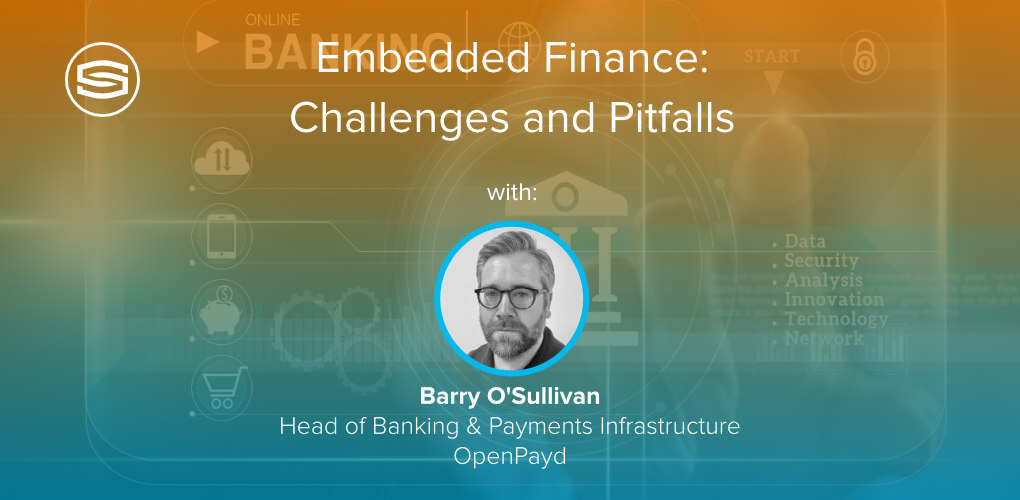
Insights & Opinions
Embedded Finance: Challenges and Pitfalls - Perspectives by OpenPayd
Mon, 11 Sep 2023


Embedded finance is the new talk in town. Juniper predicts that it will surpass $183 billion by 2027. We all read about the opportunities of embedded finance. That made us curious about the challenges and pitfalls of building the ultimate embedded finance offering. What should financial institutions be most careful about, and how have existing providers dealt with that?
In the first interview in a series of many more to come, we spoke about that with OpenPayd's Barry O'Sullivan, Head of Banking and Payments Infrastructure.
OpenPayd is a well-known organisation in the UK. Because The Banking Scene's geographical focus is Benelux, could you please briefly explain to our audience who OpenPayd is?
Barry O'Sullivan: OpenPayd is a technology-led company providing financial infrastructure for corporate customers. We are regulated by the FCA in the UK and in Malta with an e-Money licence, servicing businesses throughout Europe.
Typically, we’re the go-to infrastructure provider for corporate entities that need payment solutions, or that have other financial needs but lack the tech or the payment rails to service their customers. In addition, we provide solutions for digital asset companies that are looking for support in their fiat offering, allowing customers to move money in and then invest in digital assets easily.
With our API, customers can easily integrate with OpenPayd, selecting from an array of financial products. It might be that they want, say, multicurrency accounts, or they might want global payments, Faster Payments, or SEPA access. They can pick and choose which products they want to add and then obviously offer those out to their customers.
How would you define embedded finance, and would you consider it the same as Banking-as-a-Service?
At first it may seem that they’re identical but I don't think they are. I would say that Banking-as-a-Service describes the underlying services - so the combination of technology, financial products and regulatory coverage that a BaaS provider like OpenPayd offers.
In contrast, embedded finance describes the use cases that companies can build with BaaS. It’s the customer-facing e-wallet or payment service that a non-financial brand can deliver when they partner with a BaaS provider.
What exact services do you offer to third parties in that respect?
Barry O'Sullivan: We offer our customers an incredible head-start in terms of technology. A company can seamlessly integrate into our technology platform and benefit from a number of solutions.
For instance, a UK entity looking to send and receive payments in the US, Europe, or Latin America. Rather than spending the time, money, resources, compliance, and legal to set up that infrastructure in-house, they can integrate with us.
From a banking perspective, we ensure that those rails are available for customers. Across Europe, we can issue virtual accounts to customers so those without that infrastructure in place can easily get access to SEPA instant payments. We also provide multicurrency accounts.
As a payments and banking services provider, over and above the solutions we offer, we handle the regulatory requirements that our customers need to remain compliant - our large and experienced compliance department manages the required screening before passing transactions to the regulated financial institutions we work with.
A few months back you told The Fintech Times: “I think that success or failure in Banking-as-a-Service will hinge on the underlying technology and infrastructure”. Is technology where the most significant challenge lies, in your opinion?
Barry O'Sullivan: I think it's one of them. Obviously, if you're a company that services end users, I think the key to anything is having seamless and frictionless services that are easy to use.
I use this example quite frequently because it's quite a relevant example, I was on an app on my phone to buy something. And when I got to the payment page, I didn't have my card with me. And that's the only method they had. So I cancelled, abandoned the cart, and bought from another business that offered Apple Pay as a payment method.
If the technology aspect isn't up to standard, it doesn't matter what your customers are doing. Only with the right tech and solutions can you get them onboard… So yes, the technology part is one of the biggest requirements for embedded finance, but it's also one of the biggest challenges.
In addition, getting the underlying banking infrastructure right to enable the offering of different payment methods can be challenging too. In Europe for example, you've got people from different countries asking for different solutions. With the right infrastructure, you can grow globally and scale.
I raised this question in our +75k member LinkedIn Group Innovation in Payments. In my poll, I asked what is the biggest pitfall in offering embedded finance. 55% responded compliance and 23% technology. What is your take on this?
Barry O'Sullivan: Naturally, people look at it through their own lens, of course. As my focus is on banking infrastructure I see that there are significant challenges when it comes to getting the underlying infrastructure right in embedded finance. So, for me, technology and infrastructure are the biggest challenges. Our compliance team would potentially say the biggest headache is compliance.
But without a doubt, these are the two most important aspects to consider when looking to implement embedded finance solutions.
Recently, Roland Berger published a report stating that the biggest concerns in embedded finance for consumers are data security (61%), transparency about services, conditions, and pricing (42%) and trust in the company's security, stability (33%). Does it sound familiar to you? And more importantly, does it make sense? Or is it the wrong perception by consumers?
Barry O'Sullivan: Personally, it looks like a fair representation of the end-user. If you're embedding lots of different services and solutions, it can be difficult for the end-user to understand who's the underlying provider for which service. And then they’re likely to raise questions such as ‘where's my data going? Who owns it? Does it disappear somewhere else?’
Branding is very important nowadays. The right brand really matters in terms of trust. We're in a world where younger consumers are taking advice from influencers they see on TikTok and other social media platforms, rather than speaking with a bank about financial matters.
So yes, I think that the branding, the security and stability of the company is something that really matters to the end users, although price will always be a driver for somebody who’s looking to buy something on the fly.
But I would say that people's data and security is always going to be the highest concern.
Credit is not part of the OpenPayd offering today. Is it because it requires a more stringent license? Or because the credit risks are not worth expanding the value proposition?
Barry O'Sullivan: It is a bit of both. Because we only serve corporate customers and typically they will prefund us, so they'll have money. It's never been valuable for us to be offering credit. If you go to the end user, or the consumer part, where you're potentially offering Buy Now Pay Later or some other form of lending, it would come from a different company.
Currently we are not providing credit solutions because we don’t see the need in the existing business model and services we offer.
One last question: what makes your positioning so different from many others who are discovering embedded finance these days as well?
Barry O'Sullivan: Good question. We’ve worked on specific verticals like Financial Institutions, digital assets and marketplaces for a long time now. And we’ve built the positions that our customers need and then expanded on it.
That puts us in a position of strength as we understand what those verticals need. If you look at our growth over the last 12 months, even in the troubled economy, we've gone from a €10 billion annualised flow to €36 billion. And then we've seen the number of transactions more than quadruple. We've been acquiring a new customer base within those verticals quite rapidly.
We know we're adding value to them because of our knowledge. We're still not a big corporate engine, so we have teams that can implement fixes for our customers when they need it. The agility we have with them shows out.
Some of our digital asset clients have come to us to move all their customer base and implement a million and a half IBANs within a couple of days, which we've delivered.
So over and above our leading technology and compliance, what differentiates us is that we're able to scale at pace with our customers, and that's where we're winning over others.



